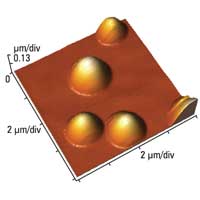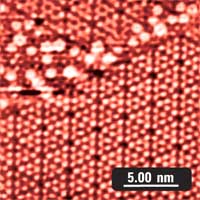Non-Contact Mode
UHV conditions
HQ:NSC AFM probes for non-contact mode
HQ:NSC15/Al BS
High-resolution in UHV
Hi'Res-C AFM probes for non-contact mode
Hi'Res-C15/Cr-Au
In non-contact mode, the long-distance van der Waals forces are sensed by an oscillating AFM probe, which is excited at its resonance frequency by a piezoelectric transducer and brought in close proximity to a sample. The AFM probe oscillation amplitudes are typically in the range of 1nm or less. The resolution in this mode is defined by the tip-sample separation of a few nanometers. For the scanning feedback either the vibration amplitude (amplitude modulation mode, AM) or the frequency shift (frequency modulation, FM) of the AFM probe can be used.
In Fig. 1 an image of microdrops of a liquid n-alkane on a silanized silicon substrate is shown. The use of non-contact mode allowed scanning without influencing the shape of the microdroplets by tip-sample forces.
|
Fig.1. Microdrops of a liquid n-alkane observed by AFM in noncontact mode. Image courtesy of A. Checco. |
 |
To improve resolution in non-contact mode, enhancement of the sensitivity to short-range tip-sample forces is needed. To do this, small amplitudes of oscillation and small tip-sample distances are commonly used. Advances in the development of the non-contact mode allow for the discovery of single defects in atomic lattices. An image of the Si 7x7 surface obtained in non-contact mode is presented in Fig. 2.
| Fig.2. AFM image of Si (111) 7x7 acquired in noncontact mode on JEOL JSPM-4500A. |
 |
Operation at distances near the sample demands fine tip-force control and the absence of surface contamination. That is why this technique is mostly used in ultrahigh vacuum.
In most cases, the AFM cantilever of choice for this mode is one with a high force constant in the range 20-100N/m so that it does not stick to the sample surface at small amplitudes. Between two AFM cantilevers having the same force constant, it is better to use the one with the higher resonance frequency. This AFM cantilever is generally faster and less noisy. Low-frequency AFM cantilevers are used with AFM systems that do not support AFM probes with short AFM cantilever arms.
Not surprisingly, imaging in non-contact mode is performed with silicon AFM probes usually applied for tapping mode operation. It is likely that in the near future, commercial AFM instruments will operate in all oscillatory modes and the development of fast, broadband controllers will lead to new multi frequency techniques.
Non-Contact Mode
UHV conditions
HQ:NSC AFM probes for non-contact mode
HQ:NSC15/Al BS
High-resolution in UHV
Hi'Res-C AFM probes for non-contact mode
Hi'Res-C15/Cr-Au